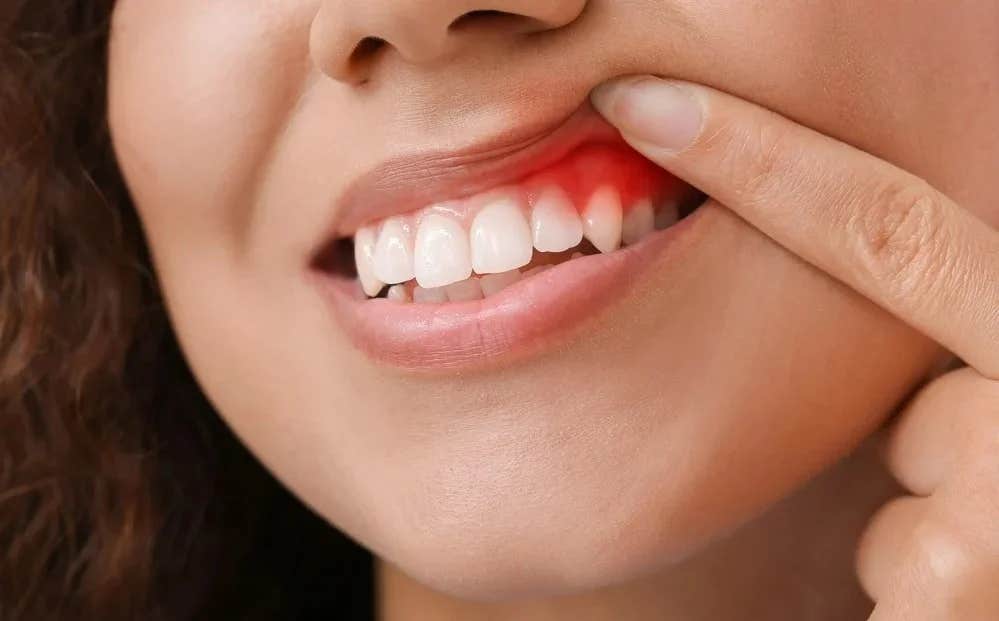Breakthrough topical gel treats and prevents gum disease at home
A topical gel that blocks the succinate receptor reduces gum disease by suppressing inflammation and balancing oral bacteria, offering a novel treatment.

The research lays the groundwork for a non-invasive treatment for gum disease that people could apply to the gums at home to prevent or treat gum disease. (CREDIT: CC BY-SA 3.0)
A new study suggests that a topical gel blocking the receptor for a metabolic byproduct called succinate can effectively treat gum disease. By suppressing inflammation and altering the makeup of bacteria in the mouth, this gel could offer a non-invasive solution to a prevalent issue. Researchers from NYU College of Dentistry led this work, and their findings were recently published in Cell Reports.
Gum disease, or periodontitis, affects nearly half of adults aged 30 and older. It’s an inflammatory condition that involves three main components: inflammation of the gums, an imbalance between harmful and beneficial bacteria in the mouth, and damage to the bones and structures supporting teeth. If left untreated, gum disease can lead to painful symptoms like bleeding gums, difficulty chewing, and eventual tooth loss.
Current treatments for gum disease are limited. As Yuqi Guo, an associate research scientist at NYU College of Dentistry and one of the study’s co-authors, explains, “No current treatment for gum disease simultaneously reduces inflammation, limits disruption to the oral microbiome, and prevents bone loss. There is an urgent public health need for more targeted and effective treatments for this common disease.”
The study builds on earlier research that linked elevated levels of succinate, a molecule produced during metabolism, to gum disease. Higher succinate levels are associated with increased inflammation, a hallmark of periodontitis. In 2017, Guo and her team discovered that excess succinate activates a receptor that contributes to bone loss, making this receptor a promising target for treatment.
The researchers confirmed the connection between succinate and gum disease by analyzing dental plaque from human subjects and blood from mice. They found higher succinate levels in both humans and mice with gum disease compared to those with healthy gums. They also identified the presence of the succinate receptor in the gums of both species.
To explore this further, the team genetically modified mice to "knock out" the succinate receptor. These knockout mice showed lower levels of gum inflammation and bone loss compared to normal mice. They also had a healthier balance of bacteria in their mouths. Even when researchers introduced extra succinate, which worsened gum disease in normal mice, the knockout mice remained protected.
Related Stories
“Mice without active succinate receptors were more resilient to disease,” says Fangxi Xu, an assistant research scientist at NYU Dentistry and another co-author of the study. “While we already knew there was some connection between succinate and gum disease, we now have stronger evidence that elevated succinate and the succinate receptor are major drivers of the disease.”
Building on this discovery, the team developed a gel designed to block the succinate receptor. In lab tests using human gum cells, the gel reduced inflammation and bone loss. The next step was to test it on mice with gum disease. Applying the gel to their gums significantly reduced inflammation and bone loss in just a few days. One test showed that applying the gel every other day for four weeks cut bone loss in half compared to mice that didn’t receive treatment.
In addition to these benefits, the gel also changed the bacterial makeup in the mouths of treated mice. Pathogens from the Bacteroidetes family, which are commonly linked to gum disease, were significantly reduced. Importantly, further tests showed that the compound did not act as an antibiotic, meaning it didn't directly kill bacteria but instead worked by regulating inflammation.
Deepak Saxena, a professor of molecular pathobiology at NYU Dentistry and co-senior author of the study, explains, “This suggests that the gel changes the community of bacteria through regulating inflammation.”
While the results are promising, more research is needed to determine the best dosage and timing for the gel, as well as to ensure there are no harmful side effects. The goal is to create a version that people can use at home to prevent or treat gum disease, as well as a stronger formulation for professional use in dental offices.
The long-term vision includes developing an oral strip or a slow-release gel that can be applied to areas affected by gum disease. According to Xin Li, a professor of molecular pathobiology at NYU Dentistry and the lead author of the study, “Current treatments for severe gum disease can be invasive and painful. In the case of antibiotics, which may help temporarily, they kill both good and bad bacteria, disrupting the oral microbiome. This new compound that blocks the succinate receptor has clear therapeutic value for treating gum disease using more targeted and convenient processes.”
Gum disease treatment is currently far from ideal. Surgical options can be invasive, painful, and costly, while antibiotics can temporarily help but come with the risk of wiping out both harmful and beneficial bacteria, disrupting the natural balance in the mouth. This new gel offers a potential solution that targets gum disease at its root by blocking the pathway responsible for inflammation and bone loss.
If successful, this topical gel could represent a game-changer in the fight against gum disease, providing a more comfortable, non-invasive option for millions of people. It could also reduce the need for antibiotics, which often cause more harm than good by disturbing the delicate balance of bacteria in the mouth.
With further development, this gel could soon become a household staple for preventing and treating gum disease, giving you a more effective way to maintain oral health without the discomfort of traditional treatments. For those who already suffer from gum disease, this gel might just be the breakthrough needed to stop the disease in its tracks, restoring both comfort and dental health.
Additional study authors include Scott Thomas, Yanli Zhang, Bidisha Paul, Sungpil Chae, Patty Li, Caleb Almeter, and Angela Kamer of NYU Dentistry; Satish Sakilam and Paramjit Arora of NYU Department of Chemistry; and Dana Graves of the University of Pennsylvania School of Dental Medicine.
Note: Materials provided above by The Brighter Side of News. Content may be edited for style and length.
Like these kind of feel good stories? Get The Brighter Side of News' newsletter.



